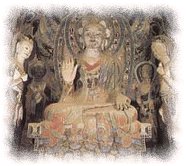The Land Of China -- Explore by Province
 |
 |
Gansu
Gansu is a mid-northwestern province that stretches along the Silk Road. The area was settled some 200,000 years ago. Its south part has rich soil and sufficient sunshine to produce honeydew melons and vegetables.

|

|
Dunhuang lies at the western end of the Gansu Corridor, called Hexi Zoulang. The name Dunhuang originally meant "prospering, flourishing"-- a hint that Dunhuang must once have been an important city. Its position at the intersection of two trade routes was what made Dunhuang flourish. The coming and going of horse and camel caravans carried new thoughts, ideas, arts, and sciences to the East and West.

|
The Yangguan Pass lies in Nanhu township 70 kilometers southwest of Dunhuang. Yangguan is often mentioned in the mural stories and documents of the Dunhuang Grottoes. What is interesting is that travellers may often find ancient relics such as bricks, pottery pieces, coins, arrows, bronze decorations, seals, and living utensils ranging from the Han to the Song dynasty in the sand dunes in the north and east of the remains of Shouchang city. Round and thin white and black stone pieces are also found; according to a book found in the Dunhuang cave, the locality, Shazhou, offered to the Tang court twenty sets of chess every year.
The Mogao Grottoes

|
25 kilometers southeast of Dunhuang are the Mogao Grottoes (the Thousand Buddha Caves). Over 1000 caves were cut, of which 492 remain today. They were abandoned and forgotten in the 11th century until archaeologists arrived to carry away huge quantities of manuscripts, textiles and other art objects. However, Magao remains a brilliant trove of Buddhist statues, carvings, gilt and colored frescoes, murals, and wall paintings from the 4th to 10th centuries. The Diamond Sutra, the oldest existing printed book, was found here and is now in the British Museum in London.
The Mogao Grottoes are located in a rare mountain gully running from south to north in this barren land, sandwiched by Minsha Mountain in the west and Sanwei Mountain in the east. The Dangguan River flows through it, nurturing a rare piece of oasis full of vitality. When entering the mountain gully, numerous caves can be seen on a stretch of 1600 meters carved out on the steep cliffs of the Minsha Mountain. It is a 1,000-year-old ancient art gallery that still lives today. The earliest cave was carved 1,630 years ago.
Each cave and each mural has its own story. The frescoes evolve one story after another, telling of the strife between the good and the evil and the extreme happy life in the paradise. Here, one feels that the heaven and the earth have unified into one. The colored sculptures, frescoes and ancient buildings were the crystallization and materialization of the spirit and life of the builders and artists and the worshippers of the day.

|
The construction of the Mogao Grottoes spanned more than a thousand years ranging from the Zhou to the Yuan Dynasties. The Great Wall, the Forbidden City and the Terra Cotta warriors of the Qin are all remarkable, yet were all built in a single dynasty. That the Mogao Grottoes as a quintessence of art, history and culture, were built and developed over 11 dynasties over more than 1,000 years is indeed unprecedented.
The art of the Mogao Grottoes is composed of cave architecture, sculptures and murals. There are now 482 caves with 4500 square meters of murals and 2500 sculptures. The Mogao art features five Tang and Song wooden cave buildings and the 50,000-volume "Dunhuang Books". The documents date back from 359 to 1196, spanning the dynastic 837 years of the Sui, Tang, and Song. They are written in the language of the ethnic Hans as well as in ten other languages. They cover the Four Confucian classics; the literature of Buddhism, Taoism, Jingism and Moniism; and other records from musical scores and choreographic records to astronomy and medical literature. The historical records cover topics such as philosophy, literature, geography, natural science, education, and textual criticism of ancient records. The treasure is one of the greatest cultural discoveries in the 20th century.



 Chinese Culture
Chinese Culture